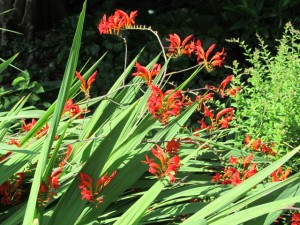This South African native, also called ‘montbretia”, thrives in full sun in well-drained average garden soil. A richly composted soil tends to boost foliage size and bloom count, but often weakens bloom stems, requiring some staking. Crocosmia may struggle in a wet soggy wintry soil. Established plants are exceptionally summer heat and drought tolerant.
Brightly colored flowers rise on wiry stems above the sword-like leaves in early July in the Southern Appalachian region (USDA zones 6 and 7). The foliage closely resembles gladiolus. Most cultivars are hybrids and vary in flower color, height and plant vigor.
Flower stalks arise from fast-multiplying underground bulbs (they’re really corms) in red, orange, yellow and mixed colors. The most popular cultivar is ‘Lucifer’, a Blooms of Bressingham introduction. ‘Lucifer’ produces vivid red flowers on 4-5 foot arching wiry stems. Crocosmias make excellent cut flowers.
Corms are planted 3 to 4 inches deep in fall or early spring. In northerly zone 5, either plant corms 6 inches deep or lift and store them by late fall. Container-grown plants are also sold at most garden shops.
Many low growing forms (not ‘Lucifer’) tend to start slow their first year, but wind up as long-lived perennials. Over the years crocosmia may become a nuisance (perhaps invasive?) as corms spread to other garden areas. Mites may draw sap (stipple) leaves in a dry summer.


 Posted in
Posted in 
